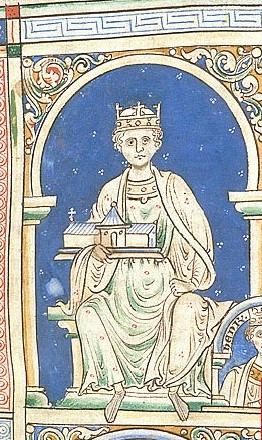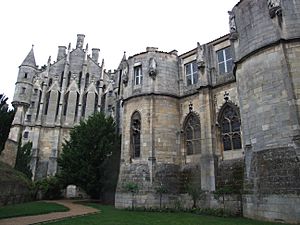Eleanor of Aquitaine facts for kids
Quick facts for kids Eleanor |
|
|---|---|
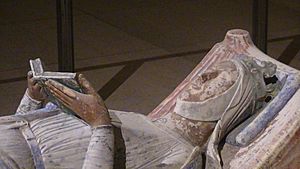
Tomb effigy at Fontevraud Abbey
|
|
| Duchess of Aquitaine | |
| Reign | 9 April 1137 – 1 April 1204 |
| Predecessor | William X |
| Successor | John |
| Queen consort of France | |
| Tenure | 1 August 1137 – 21 March 1152 |
| Coronation | 25 December 1137 |
| Queen consort of England | |
| Tenure | 19 December 1154 – 6 July 1189 |
| Coronation | 19 December 1154 |
| Born | c. 1122 Poitiers, Kingdom of France |
| Died | 1 April 1204 (aged about 82) Poitiers, Kingdom of France |
| Burial | Fontevraud Abbey, Fontevraud |
| Spouse | |
| Issue Detail |
|
| House |
|
| Father | William X, Duke of Aquitaine |
| Mother | Aénor de Châtellerault |
Eleanor of Aquitaine (born around 1122 – died 1 April 1204) was a very powerful and wealthy woman in medieval Europe. She was the Duchess of Aquitaine in her own right, meaning she inherited and ruled a large part of southwestern France. She became Queen of France by marrying King Louis VII in 1137. Later, she became Queen of England by marrying King Henry II in 1154.
Eleanor was known for her intelligence and strong will. She supported poets and artists. She also played a big role in the Second Crusade, though it was not successful. She was a key figure in the politics of England and France for many years.
Contents
Early Life and Education
Eleanor was born around 1122. Her parents were William X, Duke of Aquitaine, and Aénor de Châtellerault. Her father's court was famous for its culture and arts. Eleanor was the oldest of three children.
Eleanor received an excellent education. She learned about numbers, stars, and history. She also learned important skills like managing a household and sewing. She enjoyed talking, dancing, playing games like chess, and playing the harp. She could read and speak Latin, and knew a lot about music and books. She was also good at riding horses and hunting.
When Eleanor was about eight years old, her younger brother and mother died. This made Eleanor the main heir to her father's lands. The Duchy of Aquitaine was the largest and richest region in France. It was almost one-third the size of modern France.
Becoming a Duchess
In 1137, Eleanor's father, Duke William X, went on a pilgrimage. He died on 9 April of that year. Eleanor, who was between 12 and 15 years old, became the Duchess of Aquitaine. This made her the most sought-after heiress in Europe.
Her father's will stated that King Louis VI of France should be her guardian. He was also to find her a suitable husband. King Louis VI was very ill at the time. However, he quickly decided that his own son, also named Louis, should marry Eleanor. This would bring Aquitaine under the control of the French crown.
Within hours, arrangements were made. Louis, who was 17, traveled to Bordeaux with 500 knights.
First Marriage to Louis VII
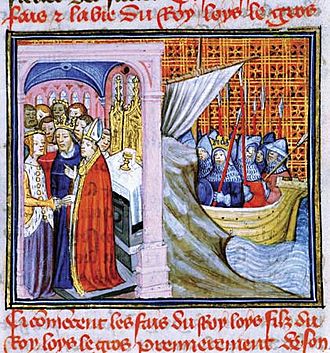
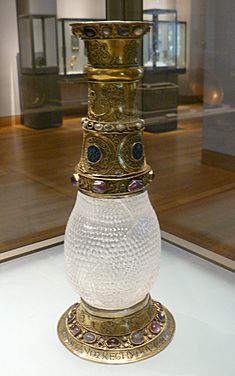
Eleanor and Louis were married on 25 July 1137 in Bordeaux. They became Duke and Duchess of Aquitaine. It was agreed that Aquitaine would stay separate from France. It would only join France if their oldest son became both king and duke. For their wedding, Eleanor gave Louis a beautiful rock crystal vase. This vase is the only item that belonged to Eleanor that still exists today.
Just a few days after their wedding, King Louis VI died. This meant Eleanor's husband became King Louis VII. They were crowned King and Queen of France on Christmas Day that same year.
Eleanor was lively and outgoing. She was not very popular with the more serious people in northern France. Her behavior was often criticized by church leaders. But King Louis was deeply in love with her. He tried to give her everything she wanted, even though her actions sometimes confused him.
Challenges and the Crusade
King Louis soon had disagreements with Pope Innocent II. Eleanor also encouraged her sister, Petronilla, to marry a powerful count named Raoul. This caused a war between Louis and Count Theobald. During this war, a church in Vitry burned down, killing many people. Louis felt very guilty about this.
In 1145, Eleanor gave birth to a daughter, Marie. Louis still felt guilty about Vitry. He decided to go on a Crusade to the Holy Land to make up for his sins.
Eleanor decided to join the Second Crusade herself. She was the feudal leader of soldiers from her own lands. She left for the Crusade in June 1147.
The Crusade was difficult and did not achieve much. Louis was not a strong military leader. In Asia Minor, the French army faced many problems. They were ambushed by Turkish forces. Many soldiers and pilgrims were killed. Some people blamed Eleanor for the disaster. They said she had too much baggage and that her soldiers did not help in the fight.
After this, the king and queen had a big disagreement. Louis wanted to go to Jerusalem. Eleanor wanted to stay in Antioch with her uncle, Raymond. She even suggested that their marriage might not be valid because they were distantly related. But Louis forced her to continue with him to Jerusalem.
The Crusade ended in failure. The royal couple had to return home.
Marriage Annulment
Eleanor and Louis grew further apart during the Crusade. Their differences became too great. When they returned to Europe, Eleanor hoped the Pope would allow them to end their marriage.
Pope Eugene III tried to help them reconcile. He even made them sleep in the same bed. This resulted in their second daughter, Alix. But the marriage was still troubled. They still did not have a son.
Finally, on 21 March 1152, their marriage was annulled. This means it was declared invalid. The reason given was that they were too closely related. Their two daughters were still considered legitimate. Louis kept custody of the daughters, and Eleanor got her lands back.
Second Marriage to Henry II
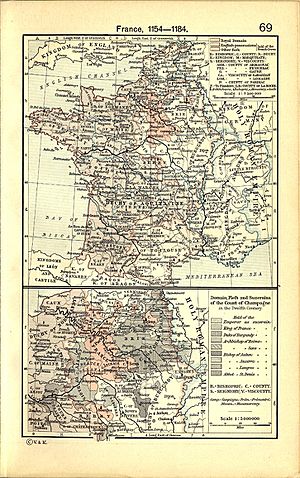
Soon after her first marriage ended, Eleanor quickly became engaged to Henry, Duke of Normandy. He was also her distant cousin. They married on 18 May 1152, just eight weeks after her annulment. Their wedding was simple, without much fanfare.
On 25 October 1154, Henry became King of England. Eleanor was crowned Queen of England on 19 December 1154. Over the next 13 years, she had five sons and three daughters with Henry: William, Henry, Richard, Geoffrey, John, Matilda, Eleanor, and Joan.
Eleanor's marriage to Henry was often difficult. Henry was not always faithful to her. Eleanor seemed to accept this, even helping to raise some of his children from other relationships.
The Court of Love in Poitiers
Between 1168 and 1173, Eleanor spent a lot of time in her city of Poitiers. Some people believe that Eleanor's court in Poitiers was a famous "Court of Love." Here, Eleanor and her daughter Marie encouraged ideas of chivalry and courtly love. This meant knights would show great respect and devotion to ladies. It might have been a way to teach good manners to young nobles.
A writer named Andreas Capellanus wrote about this court. He claimed that Eleanor and other noblewomen would listen to arguments between lovers. They would then act as a jury to decide questions about romantic love. One famous question was whether true love could exist in marriage. According to Capellanus, the women decided it was unlikely.
Some historians question if this "Court of Love" truly existed as described. They say there is little evidence for it outside of Capellanus's book. However, it is clear that Eleanor's court at Poitiers helped make the idea of courtly love popular in Europe.
Revolt and Imprisonment
In March 1173, Eleanor's oldest son, Henry, rebelled against his father, King Henry II. He felt he didn't have enough power. Eleanor may have encouraged her younger sons, Richard and Geoffrey, to join their brother. She might have also urged southern lords to support the revolt.
Eleanor left Poitiers but was arrested and sent to King Henry. Her arrest was kept secret for a year. On 8 July 1174, she was taken to England and imprisoned.
Eleanor was held captive for the next 16 years in various places in England. During this time, she grew distant from her sons. She was only released for special occasions, like Christmas.
In 1183, her son, the young King Henry, tried to rebel again. He became ill and died. Before he died, he asked his father to show mercy to his mother and set her free. King Henry II did allow Eleanor more freedom after this, but she was still supervised.
Widowhood and Later Life
When her husband, King Henry II, died on 6 July 1189, her son Richard I became king. One of Richard's first actions was to order Eleanor's release from prison. She rode to Westminster and received promises of loyalty from many lords on behalf of the new king. She ruled England in Richard's name, signing documents as "Eleanor, by the grace of God, Queen of England."
Richard was away from England for many years. He went on the Third Crusade and was later held captive. During this time, Eleanor had a lot of influence over England's affairs. She played a key role in raising the money needed to free Richard from captivity. She also wrote many letters to the Pope about her son's imprisonment, showing her deep sorrow.
Eleanor lived longer than most of her children. She was still alive during the reign of her youngest son, King John. In 1199, she traveled to Castile (in modern-day Spain) at the age of 77. King John asked her to choose one of his nieces to marry the heir to the French throne. Eleanor chose Blanche, her granddaughter. She traveled back with Blanche, but the journey was very tiring for her.
Eleanor returned to Fontevraud Abbey in France. In 1201, she became ill. When war broke out between King John and King Philip of France, Eleanor supported John. She went to Poitiers to prevent her grandson Arthur from taking control. Arthur besieged her in a castle, but John rescued her.
Eleanor died in 1204. She was buried at Fontevraud Abbey next to her husband Henry and her son Richard. Her tomb effigy shows her reading a Bible. During the French Revolution, her tomb was disturbed, and her bones were scattered. By the time she died, she had outlived all her children except King John and Queen Eleanor of Castile.
Appearance
People at the time praised Eleanor's beauty. When she was young, she was described as "more than beautiful." A famous poet called her "gracious, lovely, the embodiment of charm." He admired her "lovely eyes and noble countenance." Even when she was old, she was still described as beautiful.
However, no one left a detailed description of Eleanor. We don't know the color of her hair or eyes. Her tomb statue shows a tall woman with brown skin, but this might not be exactly how she looked.
Popular Culture
Eleanor of Aquitaine has appeared in many books, plays, films, and TV shows.
Art
Eleanor has been featured in art, such as Judy Chicago's The Dinner Party and a painting by Frederick Sandys called Queen Eleanor.
Books and Dramas
She is a main character in the play The Lion in Winter by James Goldman. This play was also made into a film. Many historical fiction novels have been written about her life, including The Courts of Love by Jean Plaidy and a three-volume series by Elizabeth Chadwick. Eleanor also appears in William Shakespeare's play The Life and Death of King John. She is the subject of a children's novel, A Proud Taste for Scarlet and Miniver, by E. L. Konigsburg.
Film, Radio and Television
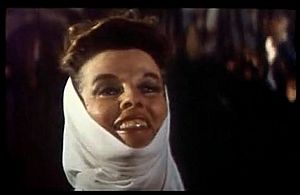
Eleanor has been played by famous actresses like Katharine Hepburn in the 1968 film The Lion in Winter. Glenn Close played her in the 2003 TV film version. She has also appeared in many Robin Hood and Ivanhoe stories on screen. Her life was also told in a BBC Radio 4 drama series called Eleanor Rising.
Music
Eleanor is thought to be the queen mentioned in a poem used in Carl Orff's famous musical work, Carmina Burana. An opera by Gaetano Donizetti called Rosmonda d'Inghilterra features Eleanor. There is also a folk ballad called "Queen Eleanor's Confession."
Video Games
In the 2019 video game Civilization VI: Gathering Storm, Eleanor is a playable leader for both the English and French civilizations.
Issue
| Name | Birth | Death | Marriage(s) |
|---|---|---|---|
| By Louis VII of France (married 12 July 1137, annulled 21 March 1152) | |||
| Marie, countess of Champagne | 1145 | 11 March 1198 | married Henry I, Count of Champagne; had children |
| Alix, countess of Blois | 1150 | 1198 | married Theobald V, Count of Blois; had children |
| By Henry II of England (married 18 May 1152, widowed 6 July 1189) | |||
| William IX, Count of Poitiers | 17 August 1153 | April 1156 | died as a baby |
| Henry the Young King | 28 February 1155 | 11 June 1183 | married Margaret of France; no surviving children. |
| Matilda, duchess of Saxony and Bavaria | June 1156 | 13 July 1189 | married Henry the Lion, duke of Saxony and Bavaria; had children |
| Richard I of England | 8 September 1157 | 6 April 1199 | married Berengaria of Navarre; no children |
| Geoffrey II, Duke of Brittany | 23 September 1158 | 19 August 1186 | married Constance, Duchess of Brittany; had children |
| Eleanor, queen of Castile | 13 October 1162 | 31 October 1214 | married Alfonso VIII of Castile; had children |
| Joan, queen of Sicily | October 1165 | 4 September 1199 | married 1) William II of Sicily 2) Raymond VI of Toulouse; had children |
| John, King of England | 27 December 1166 | 19 October 1216 | married 1) Isabella, countess of Gloucester 2) Isabella, countess of Angoulême; had children |
See also
 In Spanish: Leonor de Aquitania para niños
In Spanish: Leonor de Aquitania para niños


